Zigongosaurus, a majestic dinosaur from the late Jurassic period, captivates our imagination as we delve into the intricate details of its existence. This quadrupedal herbivore, measuring approximately 35 feet in length and weighing around 20 tons (that’s as much as two elephants 🐘🐘), walked the Earth with an elegant stride. Characterized by its long neck, lengthy tail, small head adorned with spoon-shaped teeth, and robust, elephant-like legs, Zigongosaurus was a remarkable member of the sauropodomorpha family.
Living a life dedicated to herbivory, Zigongosaurus utilized its spoon-shaped teeth to strip foliage, thriving on a plant-based diet. The creature, once believed to possess a second brain like other sauropods such as Brachiosaurus and Apatosaurus, now unveils a more nuanced truth. Recent research by paleontologists suggests that what was once thought to be a second brain was, in fact, an enlargement in the spinal cord around the hip area, surpassing the size of its relatively diminutive 🧠 brain.
With an EQ (Encephalization Quotient) registering as one of the lowest among dinosaurs, Zigongosaurus may not have boasted the intellectual prowess of its contemporaries. Despite this, it likely exhibited social behaviors, possibly migrating in herds when local food supplies dwindled. Despite not being the sharpest tool in the shed, Zigongosaurus likely had friends and might have gone on road trips with them when food got scarce 🚗. Imagine these big guys trekking through vast lands, looking for snacks 🌿!
Speculations surround the reproductive habits of Zigongosaurus, suggesting that it, like other sauropods, may have hatched from eggs laid in a linear pattern rather than in nests. This peculiar pattern hints at eggs being deposited while the creature moved, leaving a trail of dino eggs 🥚🥚, challenging traditional notions of parental care. And talk about longevity! Zigongosaurus and its pals could have lived for a century, ruling the prehistoric world.
The discovery of an almost complete Zigongosaurus skeleton in Zigong, China, provides invaluable insights into the physical attributes and structure of this ancient giant. Named by paleontologists Hou, Chao, and Chu in 1976, Zigongosaurus belongs to the Saurichian order of lizard-hipped dinosaurs. It is classified as a Sauropodomorpha, specifically a sauropod, and is affiliated with the Euhelopodidae family, known for its distinctive spoon-shaped teeth.
As we peer into the past through the fossilized remnants of Zigongosaurus, we uncover a tapestry of life in the late Jurassic period. The enigmatic features of this dinosaur, from its herbivorous lifestyle to its potential herd dynamics and unique reproductive strategies, offer a glimpse into the diverse and fascinating world of prehistoric creatures. In the ongoing saga of paleontology, Zigongosaurus stands as a testament to the ongoing exploration and discovery of Earth’s ancient inhabitants.















